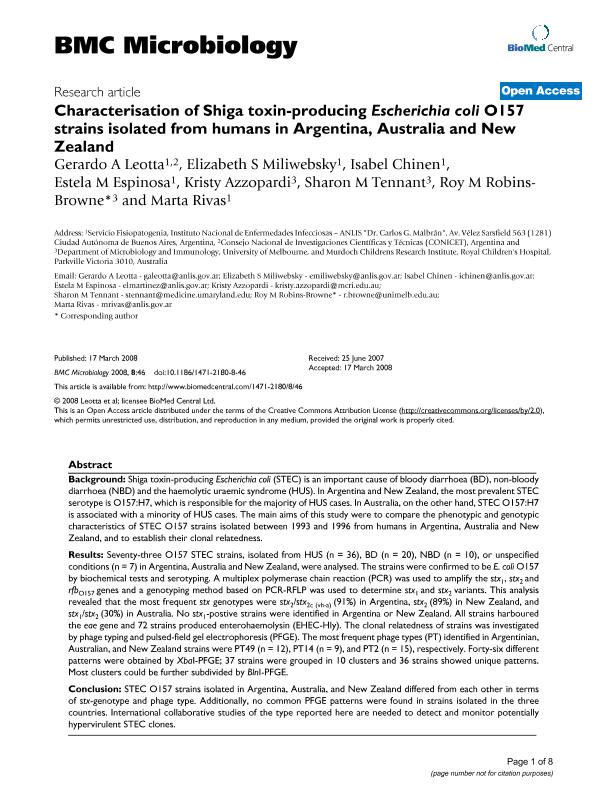Mostrar el registro sencillo del ítem
dc.contributor.author
Leotta, Gerardo Anibal

dc.contributor.author
Miliwebsky, Elizabeth S.
dc.contributor.author
Chinen, Isabel
dc.contributor.author
Espinosa, Estela M.
dc.contributor.author
Azzopardi, Kristy
dc.contributor.author
Tennant, Sharon M.
dc.contributor.author
Robins Browne, Roy M.
dc.contributor.author
Rivas, Marta

dc.date.available
2019-08-06T19:42:52Z
dc.date.issued
2008-03
dc.identifier.citation
Leotta, Gerardo Anibal; Miliwebsky, Elizabeth S.; Chinen, Isabel; Espinosa, Estela M.; Azzopardi, Kristy; et al.; Characterisation of Shiga toxin-producing Escherichia coli O157 strains isolated from humans in Argentina, Australia and New Zealand; BioMed Central; BMC Microbiology; 8; 3-2008; 1-8
dc.identifier.issn
1471-2180
dc.identifier.uri
http://hdl.handle.net/11336/81016
dc.description.abstract
Background: Shiga toxin-producing Escherichia coli (STEC) is an important cause of bloody diarrhoea (BD), non-bloody diarrhoea (NBD) and the haemolytic uraemic syndrome (HUS). In Argentina and New Zealand, the most prevalent STEC serotype is O157:H7, which is responsible for the majority of HUS cases. In Australia, on the other hand, STEC O157:H7 is associated with a minority of HUS cases. The main aims of this study were to compare the phenotypic and genotypic characteristics of STEC O157 strains isolated between 1993 and 1996 from humans in Argentina, Australia and New Zealand, and to establish their clonal relatedness. Results: Seventy-three O157 STEC strains, isolated from HUS (n = 36), BD (n = 20), NBD (n = 10), or unspecified conditions (n = 7) in Argentina, Australia and New Zealand, were analysed. The strains were confirmed to be E. coli O157 by biochemical tests and serotyping. A multiplex polymerase chain reaction (PCR) was used to amplify the stx1, stx2 and rfbO157 genes and a genotyping method based on PCR-RFLP was used to determine stx1 and stx2 variants. This analysis revealed that the most frequent stx genotypes were stx2/stx 2c (vh-a) (91%) in Argentina, stx2 (89%) in New Zealand, and stx1/stx2 (30%) in Australia. No stx 1-postive strains were identified in Argentina or New Zealand. All strains harboured the eae gene and 72 strains produced enterohaemolysin (EHEC-Hly). The clonal relatedness of strains was investigated by phage typing and pulsed-field gel electrophoresis (PFGE). The most frequent phage types (PT) identified in Argentinian, Australian, and New Zealand strains were PT49 (n = 12), PT14 (n = 9), and PT2 (n = 15), respectively. Forty-six different patterns were obtained by XbaI-PFGE; 37 strains were grouped in 10 clusters and 36 strains showed unique patterns. Most clusters could be further subdivided by BlnI-PFGE. Conclusion: STEC O157 strains isolated in Argentina, Australia, and New Zealand differed from each other in terms of stx-genotype and phage type. Additionally, no common PFGE patterns were found in strains isolated in the three countries. International collaborative studies of the type reported here are needed to detect and monitor potentially hypervirulent STEC clones.
dc.format
application/pdf
dc.language.iso
eng
dc.publisher
BioMed Central

dc.rights
info:eu-repo/semantics/openAccess
dc.rights.uri
https://creativecommons.org/licenses/by/2.5/ar/
dc.subject
Escherichia Coli
dc.subject
Shiga Toxin
dc.subject
Humans
dc.subject
Bloody Diarrhoea
dc.subject
Haemolytic Uraemic Syndrome
dc.subject
Haemolytic
dc.subject
Syndrome
dc.subject
Clonal Relatedness
dc.subject
Toxin Profile
dc.subject
Argentinian Strain
dc.title
Characterisation of Shiga toxin-producing Escherichia coli O157 strains isolated from humans in Argentina, Australia and New Zealand
dc.type
info:eu-repo/semantics/article
dc.type
info:ar-repo/semantics/artículo
dc.type
info:eu-repo/semantics/publishedVersion
dc.date.updated
2019-07-12T16:15:43Z
dc.journal.volume
8
dc.journal.pagination
1-8
dc.journal.pais
Reino Unido

dc.journal.ciudad
Londres
dc.description.fil
Fil: Leotta, Gerardo Anibal. Consejo Nacional de Investigaciones Científicas y Técnicas; Argentina. Dirección Nacional de Instituto de Investigación. Administración Nacional de Laboratorio e Instituto de Salud “Dr. C. G. Malbrán”; Argentina
dc.description.fil
Fil: Miliwebsky, Elizabeth S.. Dirección Nacional de Instituto de Investigación. Administración Nacional de Laboratorio e Instituto de Salud “Dr. C. G. Malbrán”; Argentina
dc.description.fil
Fil: Chinen, Isabel. Dirección Nacional de Instituto de Investigación. Administración Nacional de Laboratorio e Instituto de Salud “Dr. C. G. Malbrán”; Argentina
dc.description.fil
Fil: Espinosa, Estela M.. Dirección Nacional de Instituto de Investigación. Administración Nacional de Laboratorio e Instituto de Salud “Dr. C. G. Malbrán”; Argentina
dc.description.fil
Fil: Azzopardi, Kristy. University of Melbourne; Australia
dc.description.fil
Fil: Tennant, Sharon M.. University of Melbourne; Australia
dc.description.fil
Fil: Robins Browne, Roy M.. University of Melbourne; Australia
dc.description.fil
Fil: Rivas, Marta. Dirección Nacional de Instituto de Investigación. Administración Nacional de Laboratorio e Instituto de Salud “Dr. C. G. Malbrán”; Argentina
dc.journal.title
BMC Microbiology

dc.relation.alternativeid
info:eu-repo/semantics/altIdentifier/url/https://bmcmicrobiol.biomedcentral.com/articles/10.1186/1471-2180-8-46
dc.relation.alternativeid
info:eu-repo/semantics/altIdentifier/doi/http://dx.doi.org/10.1186/1471-2180-8-46
Archivos asociados
